卤化物离子调制的手性协同作用在共组装AIEgen-CNC复合材料中的圆偏振发光
IF 12.1
2区 材料科学
Q1 CHEMISTRY, MULTIDISCIPLINARY
引用次数: 0
摘要
追求创新的调制策略和高不对称系数(glum)仍然是开发圆偏振发光(CPL)材料的基石。传统的方法采用自下而上的手性小分子自组装或自上而下的非手性发光团与超分子手性模板(例如,纤维素纳米晶体(cnc),液晶)的共组装。这些模板充当预先设计的“模具”,在手性矩阵中对齐非手性发射体。然而,手性小分子与这些模板的共组装仍然没有得到充分的探索,受到复杂协议和有限组装控制的挑战,提出了关于超分子手性相互作用的基本问题。在此,我们阐明了手性聚集诱导发射(AIE)分子(PN-Phe卤化物)与cnc之间的共组装和相互作用。卤化物离子(F -, Cl -, Br -和PF6 -)深刻调节PN-Phe自组装,决定不同的形态,包装,热效应信号,荧光量子产率(QY)和寿命。与pn - ph - br -(−2.8 × 10−3)相比,pn - ph - cl -表现出最高的胶密度(−4.1 × 10−3)。引人注目的是,共组装成cnc - ppa - pn - ph - x - (CPP-X-)复合膜扭转了这一趋势:CPP-Cl -达到了- 0.43的异常亮度,与CPP-Cl - (- 3.1 × 10 - 2)形成鲜明对比。多种颜色变化和在防伪方面的潜在应用表明了这种共组装策略的优势。这项工作强调了组装模式在构建先进CPL材料中的重要作用,揭示了卤化物离子可以作为CPL的有效调制剂。本文章由计算机程序翻译,如有差异,请以英文原文为准。

Halide Ion-Modulated Chiral Synergy in Co-Assembled AIEgen-CNC Composites for Circularly Polarized Luminescence
Pursuing innovative modulation strategies and high asymmetry factors (glum) remains a cornerstone in developing circularly polarized luminescence (CPL) materials. Conventional approaches employ either bottom-up chiral small molecule self-assembly or top-down co-assembly of achiral luminophores with supramolecular chiral templates (e.g., cellulose nanocrystals (CNCs), liquid crystals). These templates act as pre-engineered “molds” to align achiral emitters within chiral matrices. However, co-assembling chiral small molecules with such templates remains underexplored, challenged by complex protocols and limited assembly control, raising fundamental questions about supramolecular chiral interplay. Herein, we elucidate the co-assembly and interplay between chiral aggregation-induced emission (AIE) molecules (PN-Phe halides) and CNCs. Halide ions (F–, Cl–, Br–, and PF6–) profoundly modulate PN-Phe self-assembly, dictating distinct morphologies, packing, chiroptical signals, fluorescent quantum yields (QY), and lifetimes. PN-Phe-Cl– exhibits the highest glum (−4.1 × 10−3), versus PN-Phe-Br– (−2.8 × 10−3). Strikingly, co-assembly into CNC-PVA-PN-Phe-X- (CPP-X-) composite films reverse this trend: CPP-Cl– achieves an exceptional glum of −0.43, contrasting sharply with CPP-Cl– (−3.1 × 10−2). The multiple color variations and potential application in anti-counterfeiting demonstrate the advantages of this co-assembly strategy. This work highlights the significant role of assembly patterns in constructing advanced CPL materials, revealing that halide ions could serve as effective modulators for CPL.
求助全文
通过发布文献求助,成功后即可免费获取论文全文。
去求助
来源期刊

Small
工程技术-材料科学:综合
CiteScore
17.70
自引率
3.80%
发文量
1830
审稿时长
2.1 months
期刊介绍:
Small serves as an exceptional platform for both experimental and theoretical studies in fundamental and applied interdisciplinary research at the nano- and microscale. The journal offers a compelling mix of peer-reviewed Research Articles, Reviews, Perspectives, and Comments.
With a remarkable 2022 Journal Impact Factor of 13.3 (Journal Citation Reports from Clarivate Analytics, 2023), Small remains among the top multidisciplinary journals, covering a wide range of topics at the interface of materials science, chemistry, physics, engineering, medicine, and biology.
Small's readership includes biochemists, biologists, biomedical scientists, chemists, engineers, information technologists, materials scientists, physicists, and theoreticians alike.
 求助内容:
求助内容: 应助结果提醒方式:
应助结果提醒方式:


